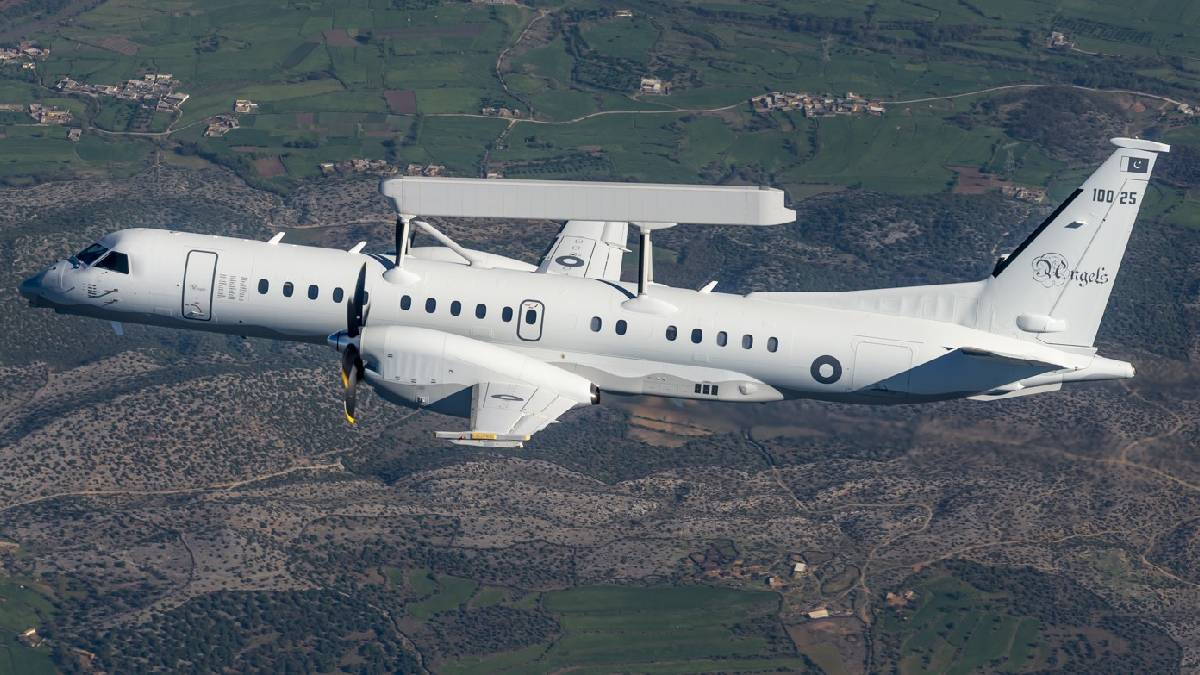SOURCE: AFI


In a significant escalation of tensions between India and Pakistan, a report by the Hindustan Times claims that the Indian Air Force (IAF) has evidence confirming the destruction of a Pakistan Air Force (PAF) Saab 2000 Erieye Airborne Early Warning and Control (AEW&C) aircraft. According to the report, the aircraft was struck by an Indian S-400 air defense system at a distance of over 350 kilometers inside Pakistani airspace. This incident, if verified, marks a major blow to the PAF’s aerial surveillance capabilities, as the report further suggests that this was not the only Erieye loss for Pakistan, with another aircraft reportedly destroyed on the ground.
The Hindustan Times report indicates that the IAF leveraged its advanced Russian-made S-400 Triumf air defense system to target the PAF’s Saab 2000 Erieye, a critical asset for airborne surveillance and command-and-control operations. The S-400, known for its long-range engagement capabilities, reportedly struck the aircraft at an unprecedented distance of over 350 kilometers, showcasing the system’s reach and precision. The Erieye, equipped with an active electronically scanned array (AESA) radar, is a high-value platform for the PAF, enabling early detection of threats and coordination of air operations.
The report also claims that a second Saab 2000 Erieye was destroyed on the ground, though details regarding the circumstances of this loss—whether through sabotage, airstrike, or other means—remain unclear. The loss of two such platforms would significantly degrade the PAF’s ability to monitor and respond to aerial threats, given the limited number of Erieye aircraft in its inventory.
In a separate but equally devastating strike, the IAF targeted PAF’s Bholari Air Base near Karachi on May 10, 2025, as part of Operation Sindoor. Retired PAF Air Marshal Masood Akhtar confirmed in an interview that four BrahMos supersonic cruise missiles struck a hangar at Bholari, destroying another Saab 2000 Erieye AEW&C aircraft on the ground. “The Pakistani pilots rushed to secure their aircraft, but the missiles kept on coming, and unfortunately, the fourth one hit the hangar at Bholari airbase, where one of our AWACS was standing. It was damaged,” Akhtar stated.
Satellite imagery from Indian firm KawaSpace and Maxar Technologies corroborated the strike, revealing severe damage to the hangar and debris near the runway, indicating the destruction of the high-value AEW&C platform. The attack also resulted in significant casualties, with reports confirming the deaths of Squadron Leader Usman Yousaf and at least four other PAF personnel, alongside numerous injuries.
The destruction of the Saab 2000 Erieye at Bholari has been termed the “Bholari Catastrophe” by defense analysts, highlighting a critical tactical error by the PAF. Despite heightened tensions, the PAF failed to redeploy or protect its high-value AEW&C aircraft, leaving it vulnerable in a hangar. The IAF’s Integrated Air Command and Control System (IACCS) had been tracking the Erieye’s movements, identifying it as a priority target. The decision to keep the aircraft grounded, rather than employing rapid refueling and redeployment, provided the IAF with a window to execute a precision strike using the BrahMos air-launched cruise missile (ALCM), likely delivered by a Sukhoi Su-30 MKI.
The loss of two Saab 2000 Erieye AEW&C aircraft—out of the PAF’s fleet of nine—represents a severe setback for Pakistan’s air defense capabilities. These platforms are critical for long-range surveillance, battle management, and coordinating fighter jets, making their destruction a significant blow to the PAF’s situational awareness. The PAF’s remaining Erieye aircraft, combined with four Chinese ZDK-03 Karakoram Eagle AWACS (retired in 2024), are now under increased pressure to fill the gap, especially amid ongoing IAF strikes on multiple PAF bases, including Nur Khan, Sargodha, and Jacobabad.
The S-400’s ability to engage targets at 350 km further complicates Pakistan’s aerial strategy, as AWACS aircraft must operate at high altitudes to maximize radar coverage, making them vulnerable to long-range SAMs. The IAF’s layered air defense system, incorporating the S-400, Akash, and Barak-8 missiles, has proven formidable, neutralizing Pakistani drones, missiles, and aircraft while protecting Indian airspace.
NOTE: AFI is a proud outsourced content creator partner of IDRW.ORG. All content created by AFI is the sole property of AFI and is protected by copyright. AFI takes copyright infringement seriously and will pursue all legal options available to protect its content.